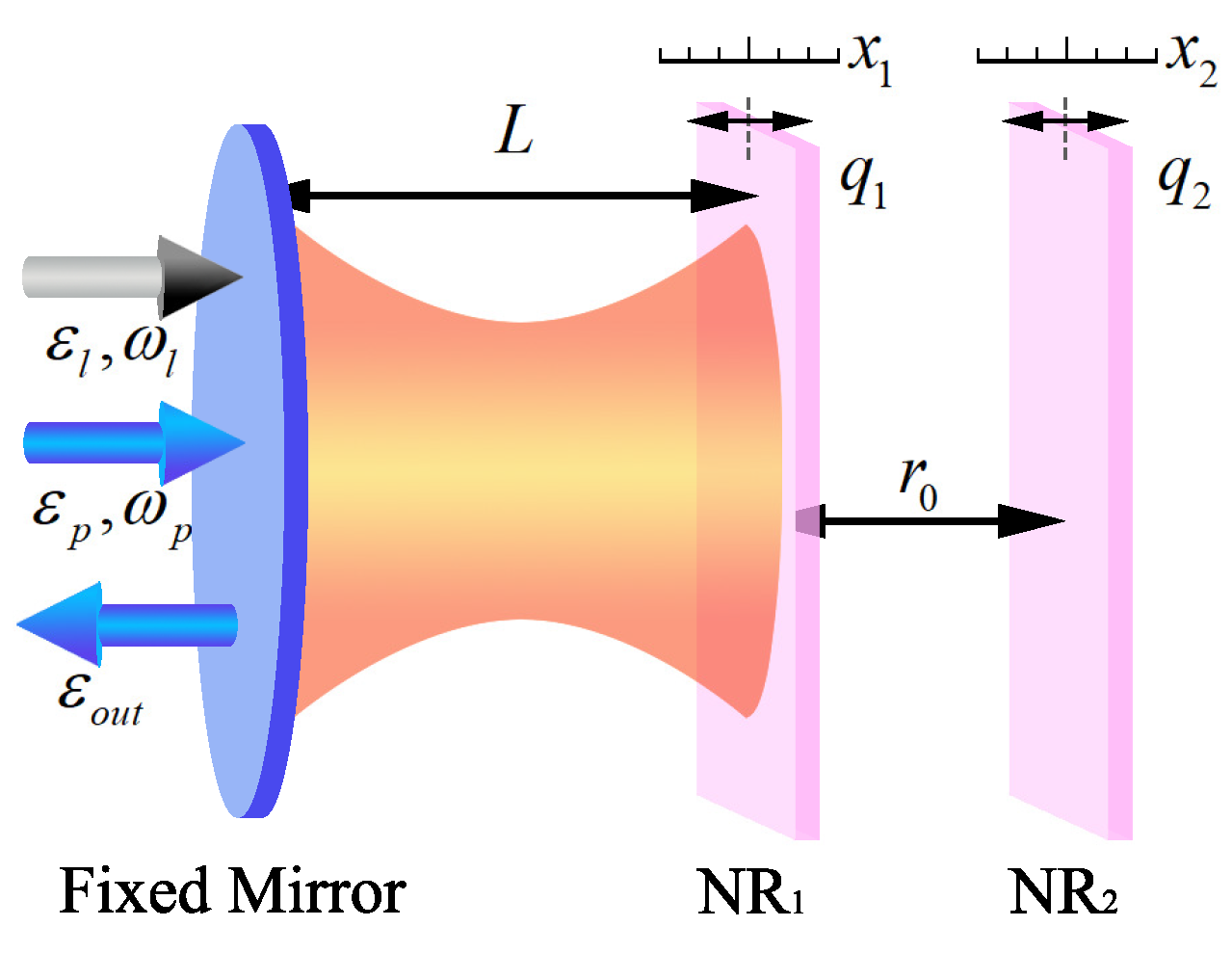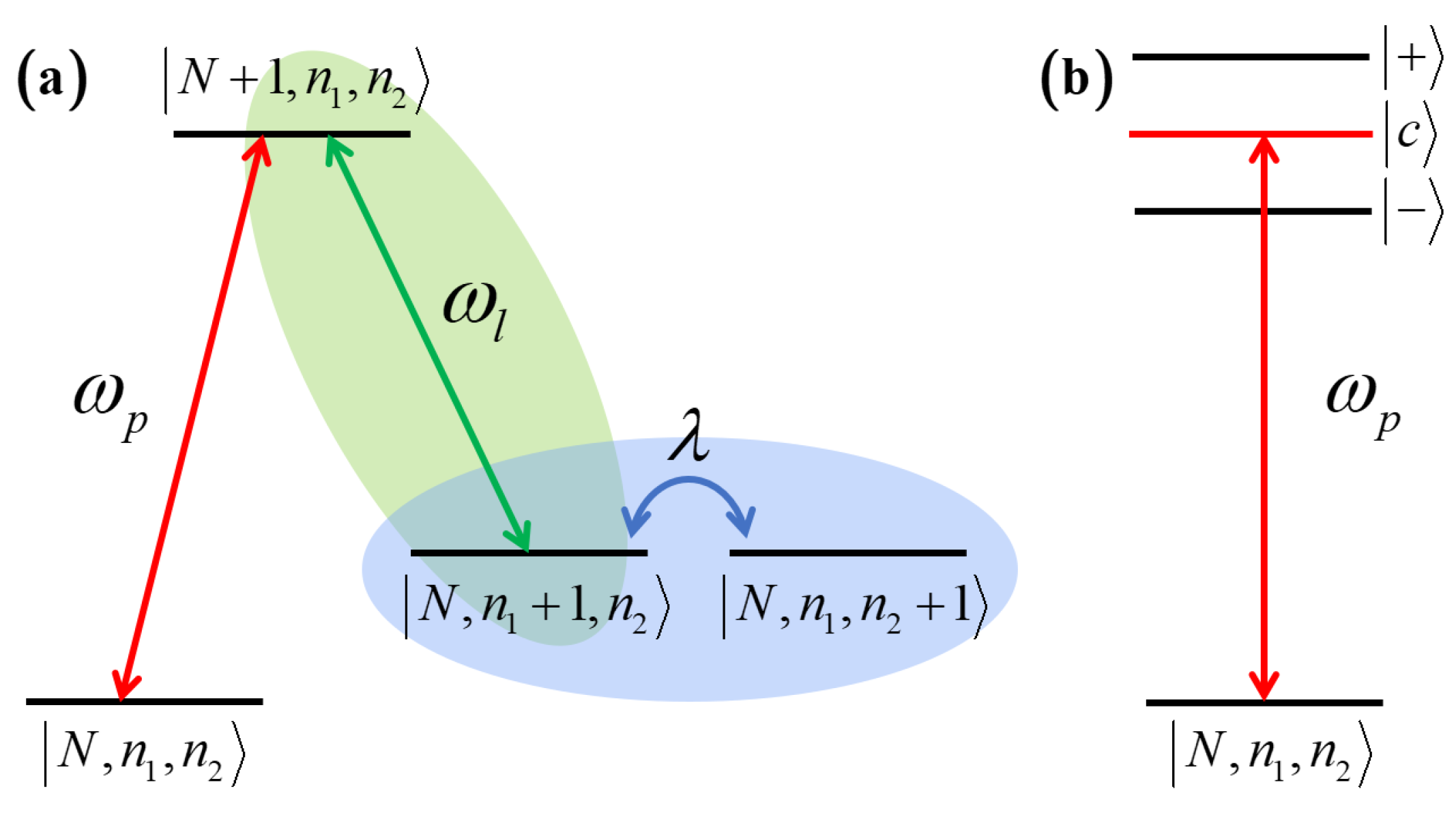Analysis of Interference Effect in Double Optomechanically Induced Transparency System
Abstract
1. Introduction
2. Theoretical Model
3. Solutions and Double OMIT
4. Analysis of Interference Effect in Double OMIT
4.1. Dressed States Analysis and Numerical Models
4.2. Analysis of Interference Effect with
4.3. Analysis of Interference Effect with
5. Discussion
Author Contributions
Funding
Institutional Review Board Statement
Informed Consent Statement
Data Availability Statement
Conflicts of Interest
References
- Weis, S.; Rivière, R.; Deléglise, S.; Gavartin, E.; Arcizet, O.; Schliesser, A.; Kippenberg, T.J. Optomechanically induced transparency. Science 2010, 330, 1520–1523. [Google Scholar] [CrossRef]
- Huang, S.M.; Agarwal, G.S. Normal-mode splitting and antibunching in Stokes and anti-Stokes processes in cavity optomechanics: Radiation-pressure-induced four-wave-mixing cavity optomechanics. Phys. Rev. A 2010, 81, 033830. [Google Scholar] [CrossRef]
- Safavi-Naeini, A.H.; Alegre, T.M.; Chan, J.; Eichenfield, M.; Winger, M.; Lin, Q.; Hill, J.T.; Chang, D.E.; Painter, O. Electromagnetically induced transparency and slow light with optomechanics. Nature 2011, 472, 69–73. [Google Scholar] [CrossRef] [PubMed]
- Han, Y.; Cheng, J.; Zhou, L. Electromagnetically induced transparency in a cavity optomechanical system with an atomic medium. J. Phys. B At. Mol. Opt. Pys. 2011, 44, 165505. [Google Scholar] [CrossRef]
- Aspelmeyer, M.; Kippenberg, T.J.; Marquardt, F. Cavity optomechanics. Rev. Mod. Phys. 2014, 86, 1391–1452. [Google Scholar] [CrossRef]
- Liu, Y.C.; Li, B.B.; Xiao, Y.F. Electromagnetically induced transparency in optical microcavities. Nanophotonics 2017, 6, 789–811. [Google Scholar] [CrossRef]
- Xiong, H.; Wu, Y. Fundamentals and applications of optomechanically induced transparency. Appl. Phys. Rev. 2018, 5, 031305. [Google Scholar] [CrossRef]
- Wang, C.Q.; Jiang, X.F.; Zhao, G.G.; Zhang, M.Z.; Hsu, C.W.; Peng, B.; Stone, A.D.; Jiang, L.; Yang, L. Electromagnetically induced transparency at a chiral exceptional point. Nat. Phys. 2020, 16, 334–340. [Google Scholar] [CrossRef]
- Tarhan, D.; Huang, S.M.; Müstecaplıoğlu, O.E. Superluminal and ultraslow light propagation in optomechanical systems. Phys. Rev. A 2013, 87, 013824. [Google Scholar] [CrossRef]
- Jing, H.; Özdemir, Ş.K.; Geng, Z.; Zhang, J.; Lü, X.Y.; Peng, B.; Yang, L.; Nori, F. Optomechanically-induced transparency in parity-time-symmetric microresonators. Sci. Rep. 2015, 5, 9663. [Google Scholar] [CrossRef]
- Lü, H.; Wang, C.Q.; Yang, L.; Jing, H. Optomechanically Induced Transparency at Exceptional Points. Phys. Rev. Appl. 2018, 10, 014006. [Google Scholar] [CrossRef]
- Agarwal, G.S.; Huang, S.M. Optomechanical systems as single-photon routers. Phys. Rev. A 2012, 85, 021801. [Google Scholar] [CrossRef]
- Du, L.; Liu, Y.M.; Jiang, B.; Zhang, Y. All-optical photon switching, router and amplifier using a passive-active optomechanical system. EPL 2018, 122, 24001. [Google Scholar] [CrossRef]
- Zhang, J.Q.; Li, Y.; Feng, M.; Xu, Y. Precision measurement of electrical charge with optomechanically induced transparency. Phys. Rev. A 2012, 86, 053806. [Google Scholar] [CrossRef]
- Zhang, Y.W.; Chen, G. Nonlinear effects in a Floquet-driven optomechanical system. Phys. Rev. A 2023, 107, 023520. [Google Scholar] [CrossRef]
- Jiménez-Marín, E.; Torres-Torres, C.; Mercado-Zú niga, C.; Vargas-García, J.; Trejo-Valdez, M.; Cervantes-Sodi, F.; Torres-Martínez, R. Interferometrically-controlled electrical currents in carbon nanotubes coated by platinum nanoparticles. Opt. Laser Technol. 2016, 85, 35–40. [Google Scholar] [CrossRef]
- Pan, G.; Yu, G.; Xiao, R.; Zhai, C. Tunable multiple optomechanically induced transparency and slow/fast light via optical parametric amplifiers in a distant electro-optical system. Eur. Phys. J. D 2024, 78, 1–8. [Google Scholar] [CrossRef]
- Huang, S.M.; Agarwal, G.S. Electromagnetically induced transparency with quantized fields in optocavity mechanics. Phys. Rev. A 2011, 83, 043826. [Google Scholar] [CrossRef]
- Fiore, V.; Dong, C.H.; Kuzyk, M.C.; Wang, H.L. Optomechanical light storage in a silica microresonator. Phys. Rev. A 2013, 87, 023812. [Google Scholar] [CrossRef]
- Wen, J.G.; Zhen, Y. Double optomechanically induced transparency in coupled-resonator system. Opt. Commun. 2014, 333, 261–264. [Google Scholar]
- Feng, L.J.; Gong, S.Q. Two-photon blockade generated and enhanced by mechanical squeezing. Phys. Rev. A 2021, 103, 043509. [Google Scholar] [CrossRef]
- Kalita, S.; Kumar, P.; Kanamoto, R.; Bhattacharya, M.; Sarma, A.K. Pump-probe cavity optomechanics with a rotating atomic superfluid in a ring. Phys. Rev. A 2023, 107, 013525. [Google Scholar] [CrossRef]
- Qu, K.; Agarwal, G.S. Fano resonances and their control in optomechanics. Phys. Rev. A 2013, 87, 063813. [Google Scholar] [CrossRef]
- Ma, P.C.; Zhang, J.Q.; Xiao, Y.; Feng, M.; Zhang, Z.M. Tunable double optomechanically induced transparency in an optomechanical system. Phys. Rev. A 2014, 90, 043825. [Google Scholar] [CrossRef]
- Wang, Q.; Zhang, J.Q.; Ma, P.C.; Yao, C.M.; Feng, M. Precision measurement of the environmental temperature by tunable double optomechanically induced transparency with a squeezed field. Phys. Rev. A 2015, 91, 063827. [Google Scholar] [CrossRef]
- Zhang, X.Y.; Zhou, Y.H.; Guo, Y.Q.; Yi, X.X. Double optomechanically induced transparency and absorption in parity-time-symmetric optomechanical systems. Phys. Rev. A 2018, 98, 033832. [Google Scholar] [CrossRef]
- Agarwal, G.S.; Huang, S.M. Electromagnetically induced transparency in mechanical effects of light. Phys. Rev. A 2010, 81, 041803. [Google Scholar] [CrossRef]
- Xiong, H.; Si, L.G.; Lv, X.Y.; Yang, X.X.; Wu, Y. Review of cavity optomechanics in the weak-coupling regime: From linearization to intrinsic nonlinear interactions. Sci. China Phys. Mech. Astron. 2015, 58, 1–13. [Google Scholar] [CrossRef]
- Liu, J.H.; He, G.Q.; W, Q.; Yu, Y.F.; Wang, J.D.; Zhang, Z.M. Fraction-order sideband generation in an optomechanical system. Opt. Lett. 2020, 45, 5169–5172. [Google Scholar] [CrossRef]
- Zhang, J.; Peng, B.; Kim, S.; Monifi, F.; Jiang, X.F.; Li, Y.H.; Yu, P.; Liu, L.Q.; Liu, Y.X.; Alù, A.; et al. Optomechanical dissipative solitons. Nature 2021, 600, 75–80. [Google Scholar] [CrossRef]
- Dobrindt, J.M.; Wilson-Rae, I.; Kippenberg, T.J. Parametric Normal-Mode Splitting in Cavity Optomechanics. Phys. Rev. Lett. 2008, 101, 263602. [Google Scholar] [CrossRef] [PubMed]
- Gröblacher, S.; Hammerer, K.; Vanner, M.R.; Aspelmeyer, M. Observation of strong coupling between a micromechanical resonator and an optical cavity field. Nature 2009, 460, 724–727. [Google Scholar] [CrossRef] [PubMed]
- Huang, S.M.; Deng, L.; Chen, A.X. Electromagnetically induced transparency with quantized fields in a dissipative optomechanical system. Phys. Rev. A 2023, 107, 013524. [Google Scholar] [CrossRef]
- Agarwal, G.S. Nature of the quantum interference in electromagnetic-field-induced control of absorption. Phys. Rev. A 1997, 55, 2467–2470. [Google Scholar] [CrossRef]
- Abi-Salloum, T.Y. Electromagnetically induced transparency and Autler–Townes splitting: Two similar but distinct phenomena in two categories of three-level atomic systems. Phys. Rev. A 2010, 81, 053836. [Google Scholar] [CrossRef]
- Anisimov, P.M.; Dowling, J.P.; Sanders, B.C. Objectively Discerning Autler–Townes Splitting from Electromagnetically Induced Transparency. Phys. Rev. Lett. 2011, 107, 163604. [Google Scholar] [CrossRef] [PubMed]
- Peng, B.; Özdemir, Ş.K.; Chen, W.J.; Nori, F.; Yang, L. What is and what is not electromagnetically induced transparency in whispering-gallery microcavities. Nat. Commun. 2014, 5, 5082. [Google Scholar] [CrossRef]
- Zhou, Y.; Chu, L.R.; Liu, Q.; Wang, C.K.; Tan, C.H. Analysis of quantum interference properties in Λ- and V-type schemes in rare-earth-ion-doped crystal with inhomogeneous broadening. J. Opt. Soc. Am. B 2019, 36, 2534–2544. [Google Scholar] [CrossRef]
- Wu, H.D.; Ruan, Y.P.; Li, Z.X.; Dong, M.X.; Cai, M.; Tang, J.S.; Tang, L.; Zhang, H.; Xiao, M.; Xia, K.Y. Fundamental Distinction of Electromagnetically Induced Transparency and Autler–Townes Splitting in Breaking the Time-Reversal Symmetry. Laser Photonics Rev. 2022, 16, 2100708. [Google Scholar] [CrossRef]
- Xiong, H.; Si, L.G.; Zheng, A.S.; Yang, X.X.; Wu, Y. Higher-order sidebands in optomechanically induced transparency. Phys. Rev. A 2012, 86, 013815. [Google Scholar] [CrossRef]
- Xiong, H.; Huang, Y.M.; Wan, L.L.; Wu, Y. Vector cavity optomechanics in the parameter configuration of optomechanically induced transparency. Phys. Rev. A 2016, 94, 013816. [Google Scholar] [CrossRef]
- Gigan, S.; Böhm, H.; Paternostro, M.; Blaser, F.; Langer, G.; Hertzberg, J.; Schwab, K.C.; Bäuerle, D.; Aspelmeyer, M.; Zeilinger, A. Self-cooling of a micromirror by radiation pressure. Nature 2006, 444, 67–70. [Google Scholar] [CrossRef]






Disclaimer/Publisher’s Note: The statements, opinions and data contained in all publications are solely those of the individual author(s) and contributor(s) and not of MDPI and/or the editor(s). MDPI and/or the editor(s) disclaim responsibility for any injury to people or property resulting from any ideas, methods, instructions or products referred to in the content. |
© 2024 by the authors. Licensee MDPI, Basel, Switzerland. This article is an open access article distributed under the terms and conditions of the Creative Commons Attribution (CC BY) license (https://creativecommons.org/licenses/by/4.0/).
Share and Cite
Liu, S.; Han, Z.; Li, D.; Tan, C. Analysis of Interference Effect in Double Optomechanically Induced Transparency System. Photonics 2024, 11, 289. https://doi.org/10.3390/photonics11040289
Liu S, Han Z, Li D, Tan C. Analysis of Interference Effect in Double Optomechanically Induced Transparency System. Photonics. 2024; 11(4):289. https://doi.org/10.3390/photonics11040289
Chicago/Turabian StyleLiu, Shengyan, Zhengkai Han, Deen Li, and Chaohua Tan. 2024. "Analysis of Interference Effect in Double Optomechanically Induced Transparency System" Photonics 11, no. 4: 289. https://doi.org/10.3390/photonics11040289
APA StyleLiu, S., Han, Z., Li, D., & Tan, C. (2024). Analysis of Interference Effect in Double Optomechanically Induced Transparency System. Photonics, 11(4), 289. https://doi.org/10.3390/photonics11040289




